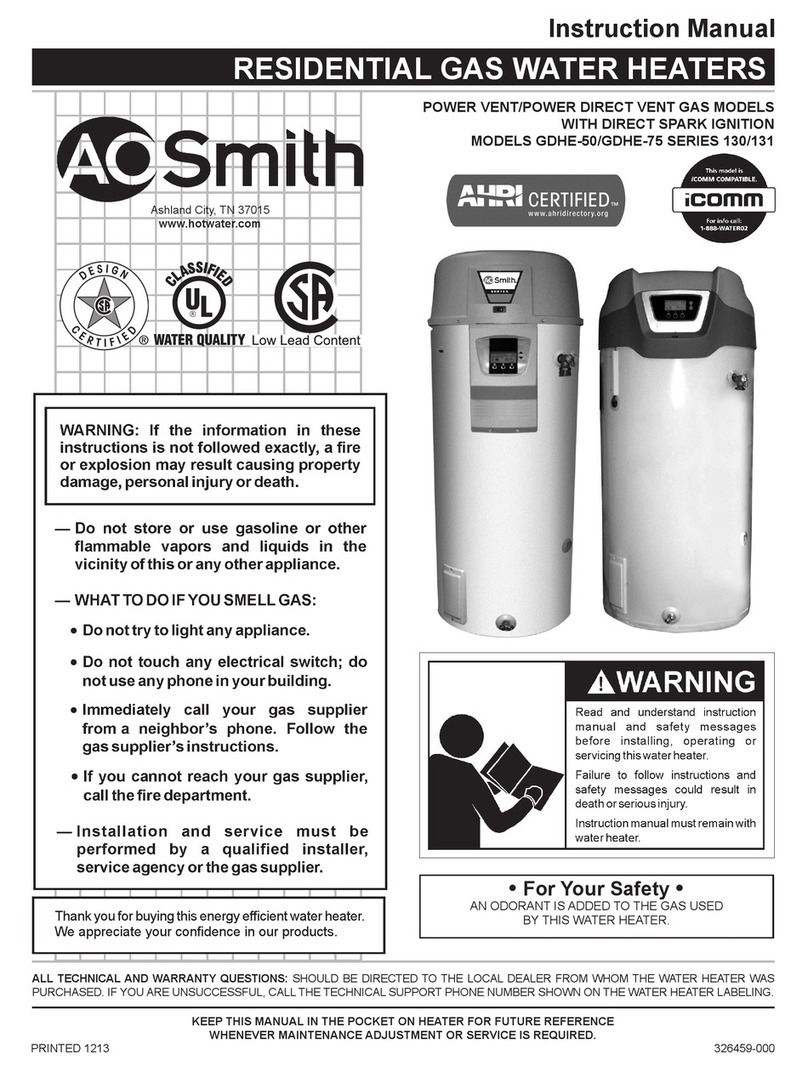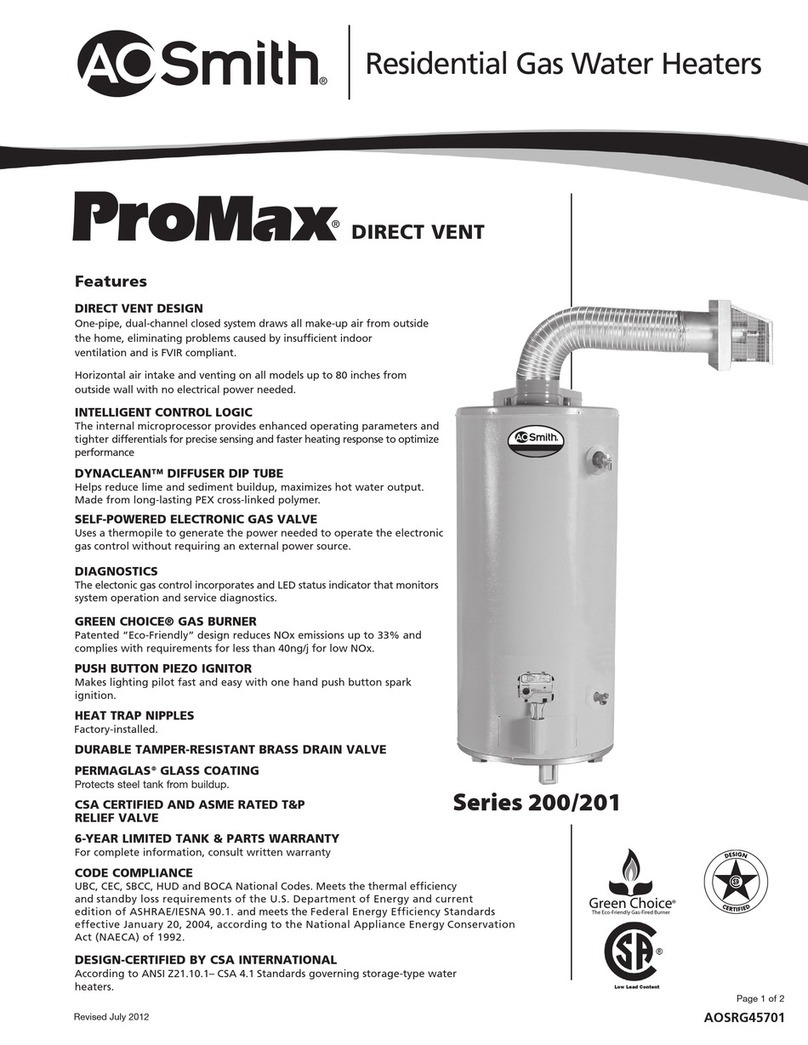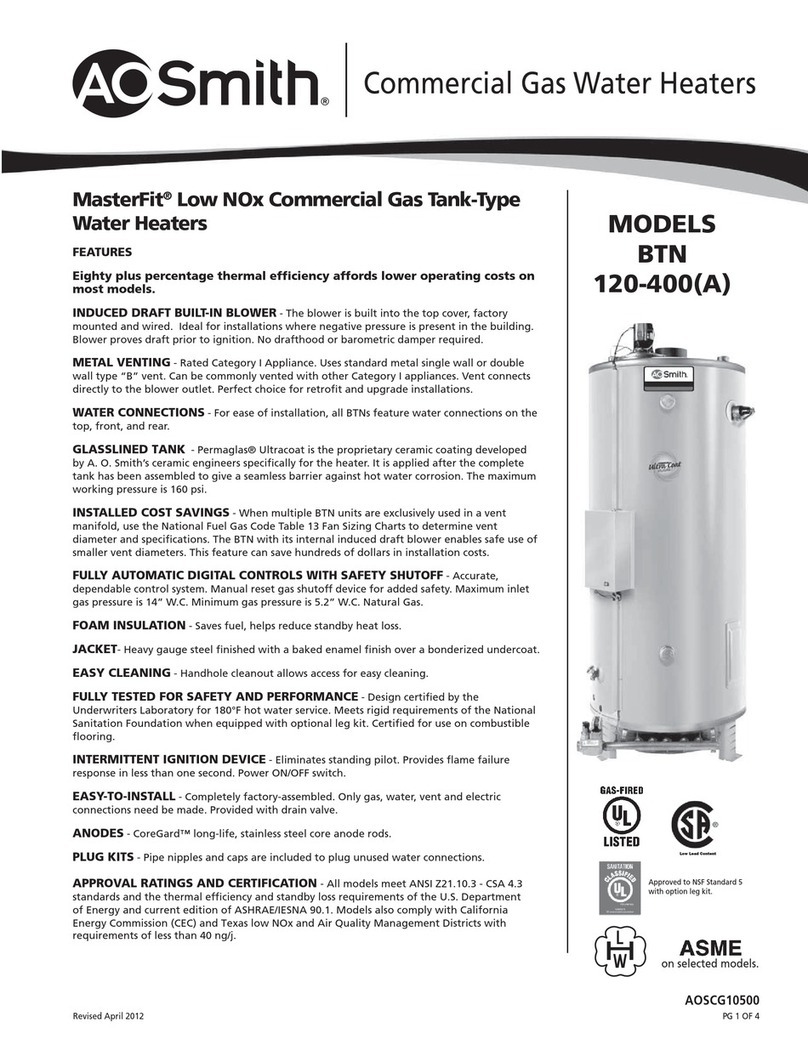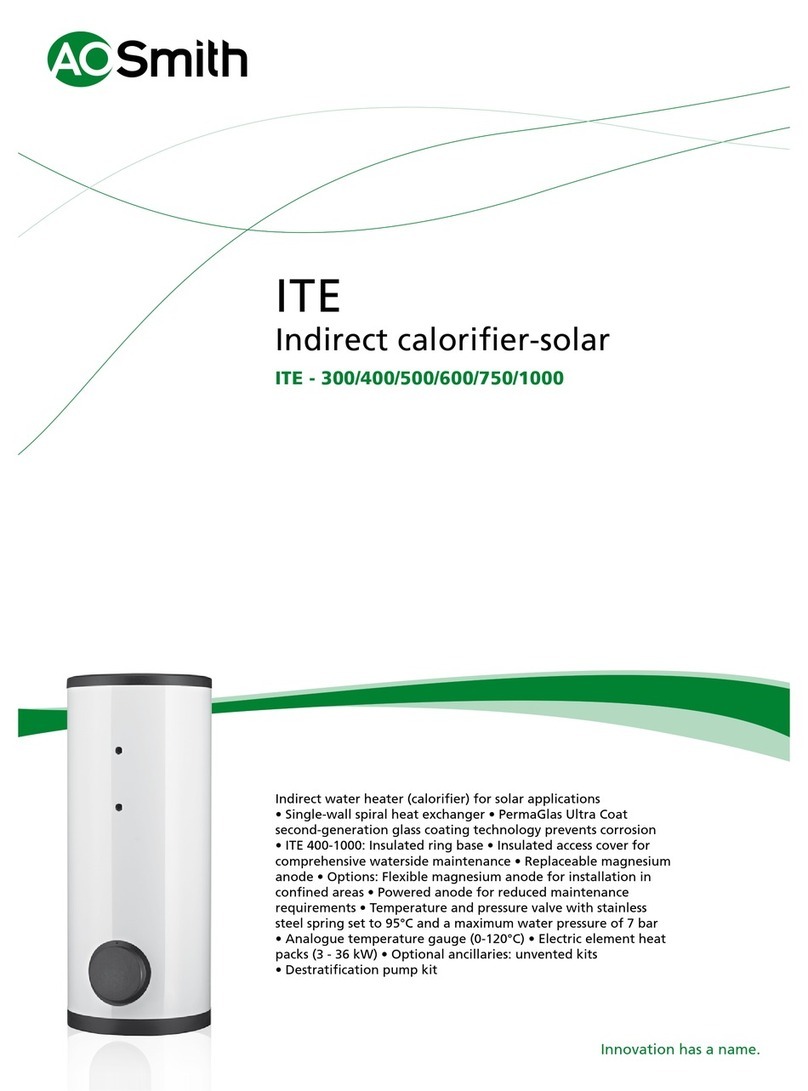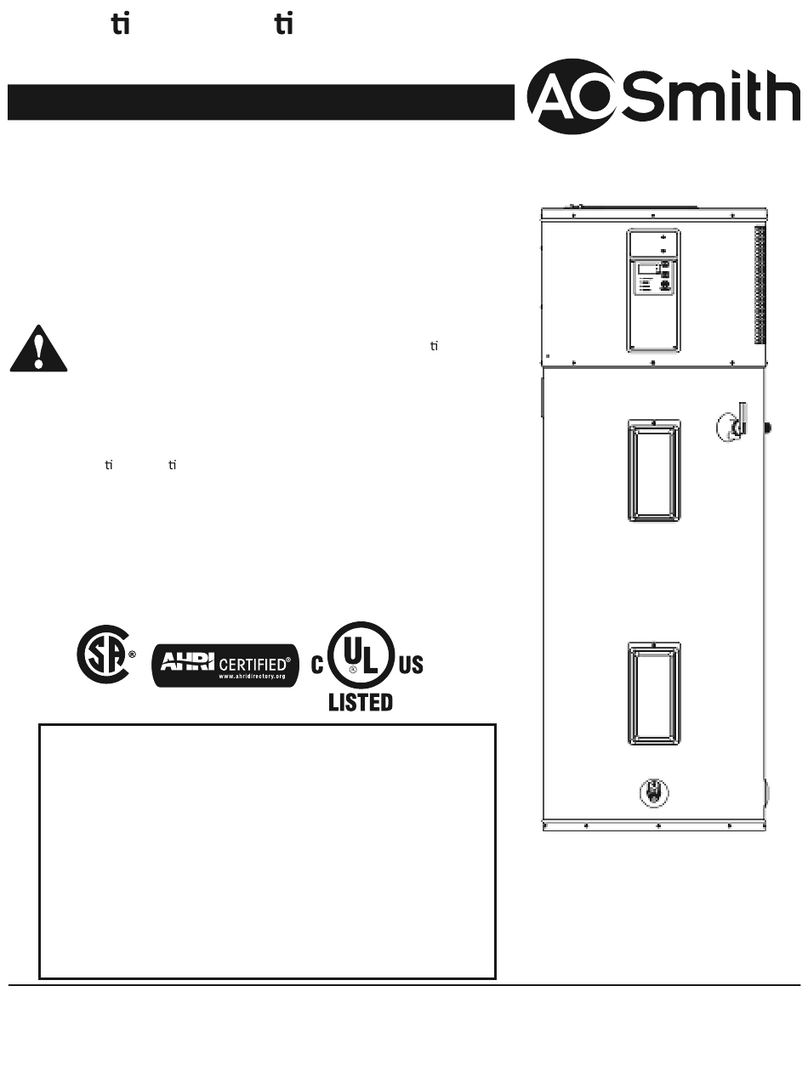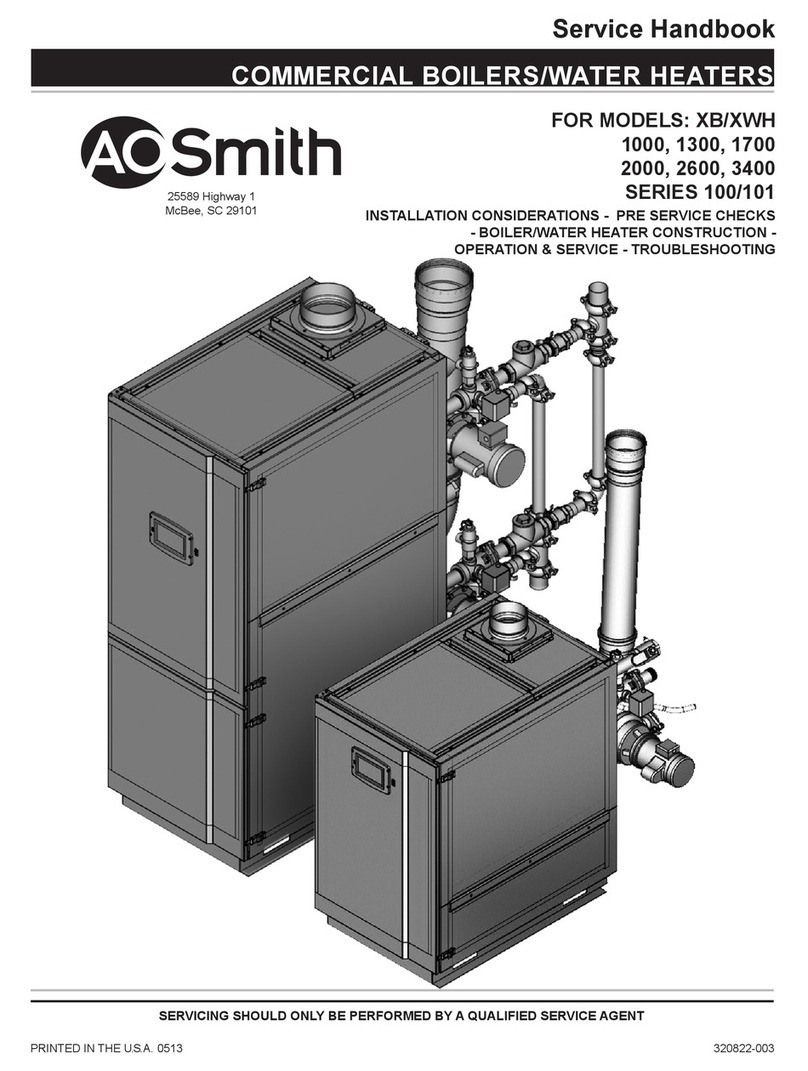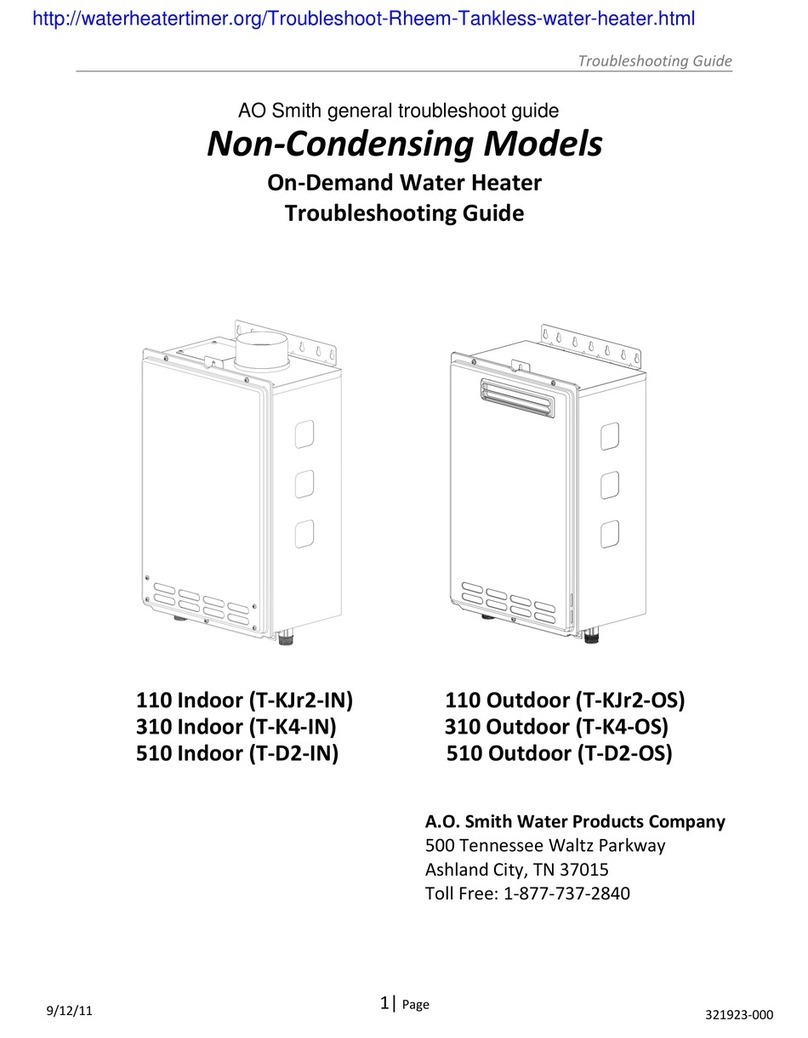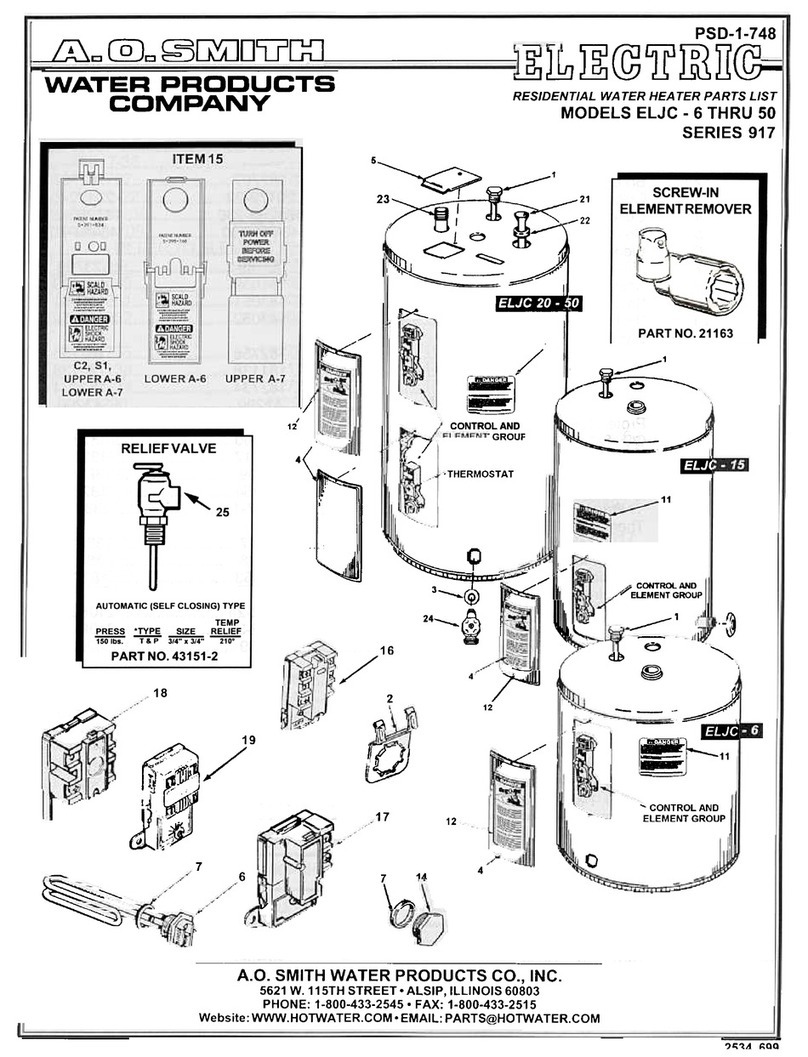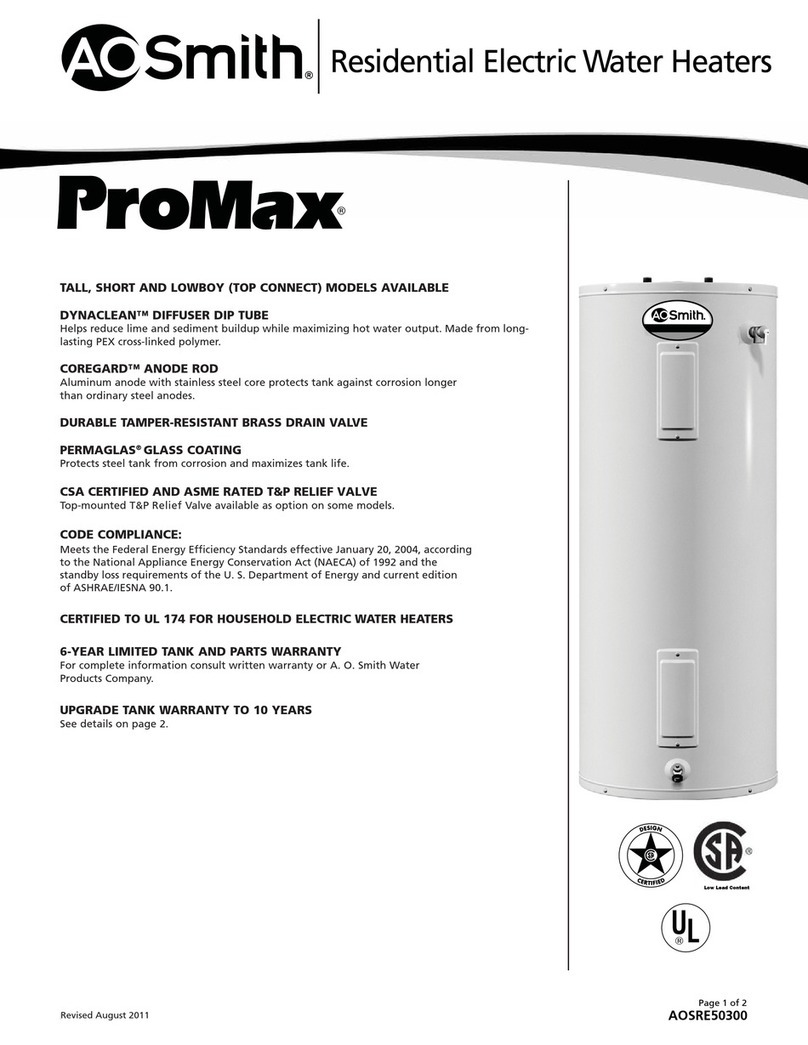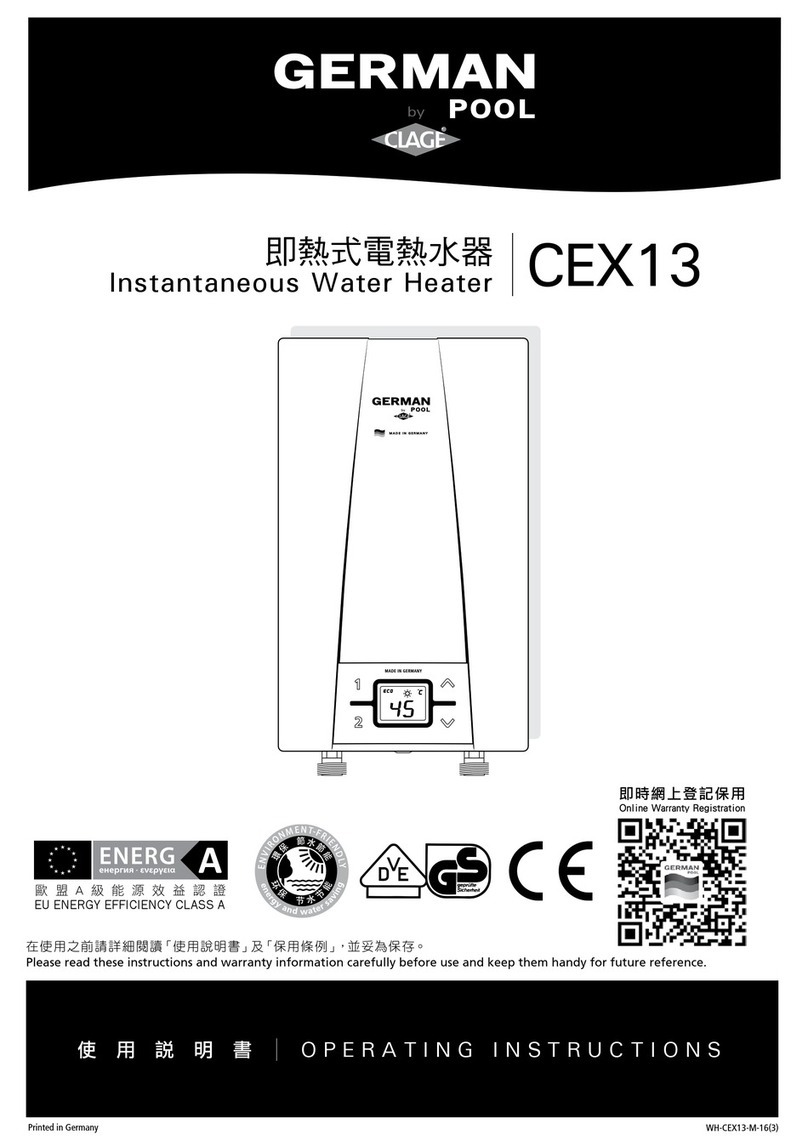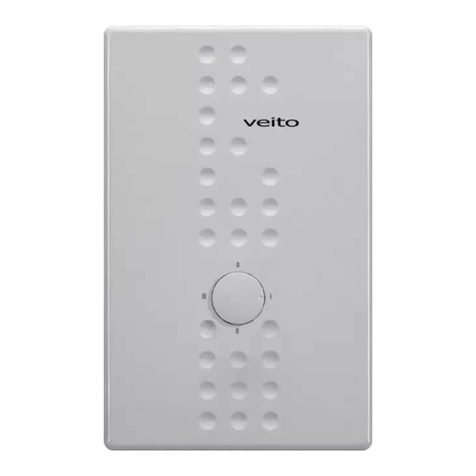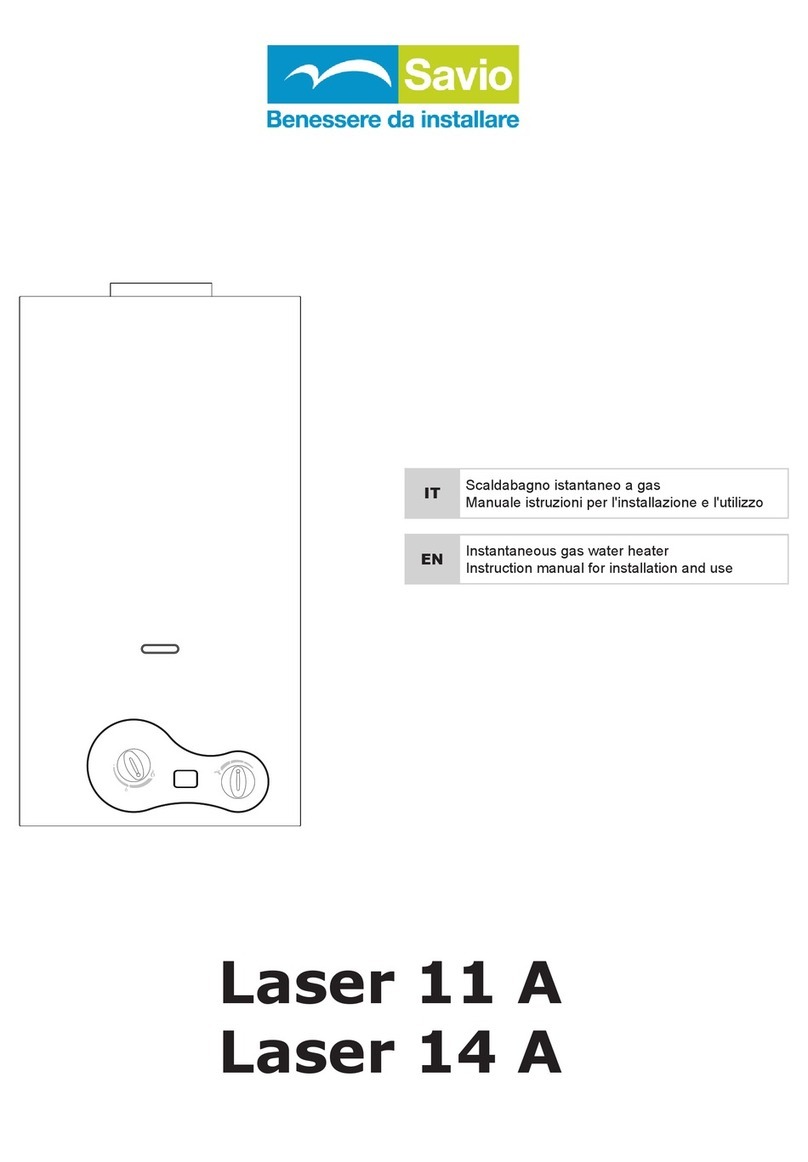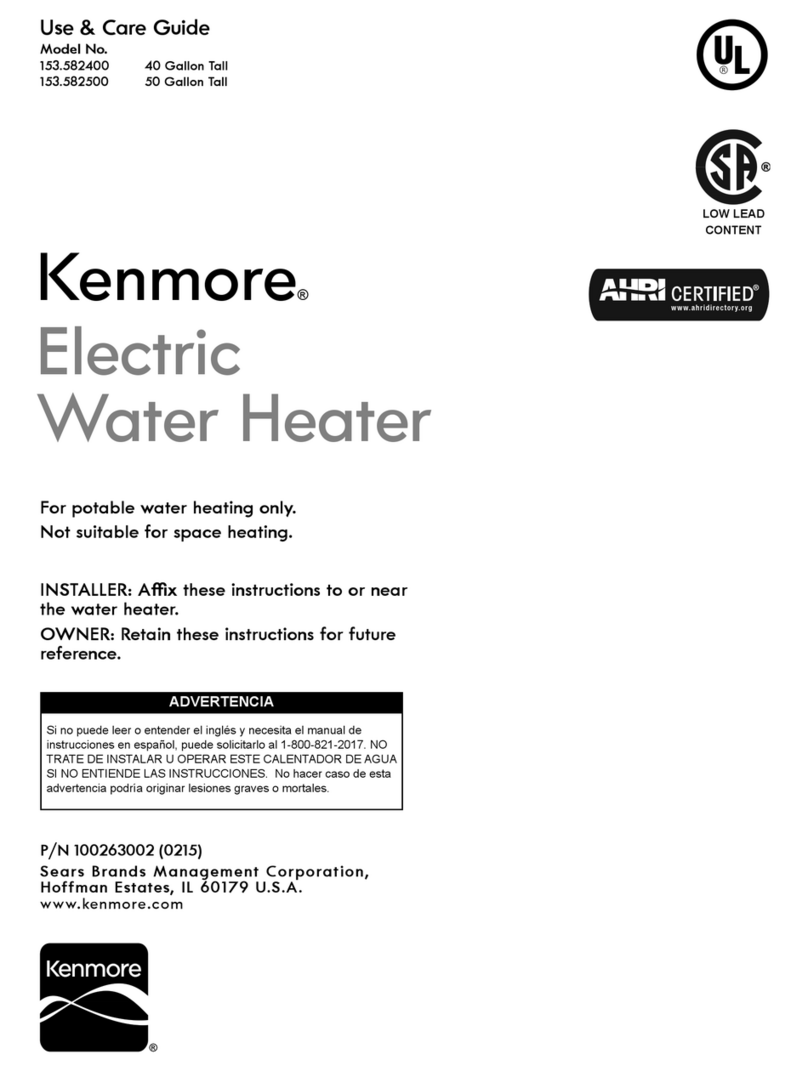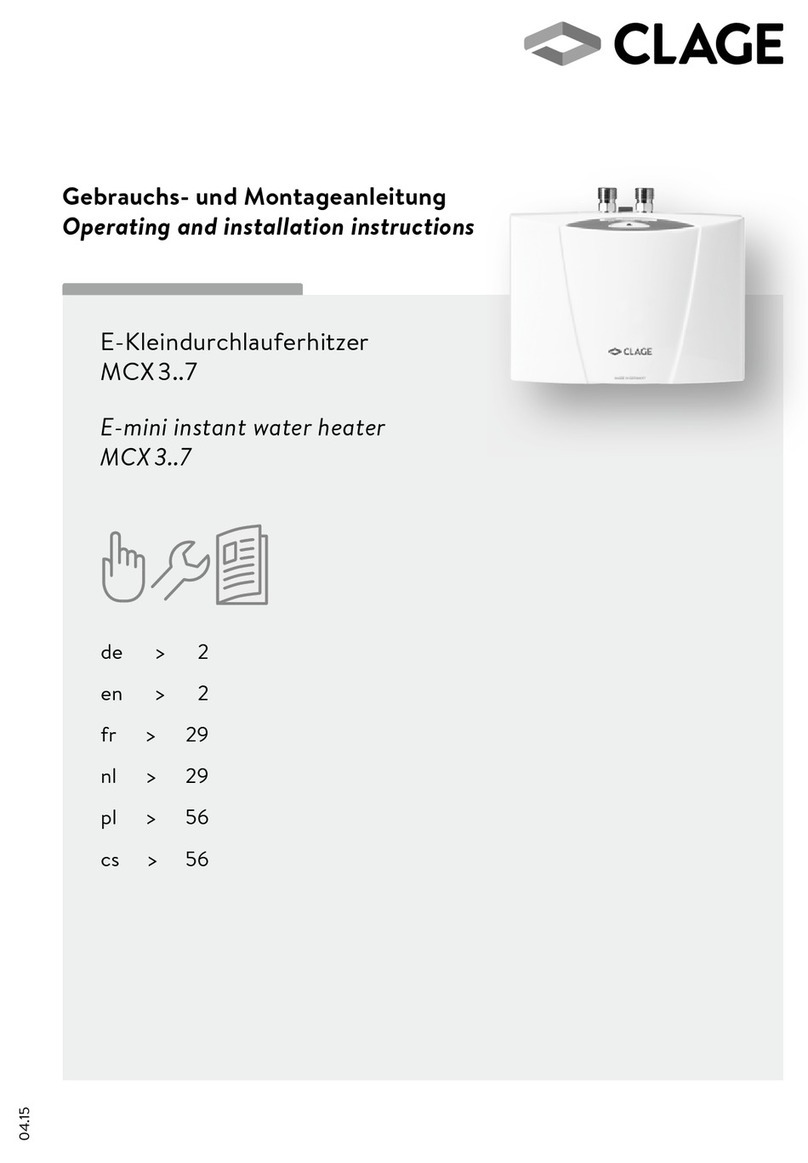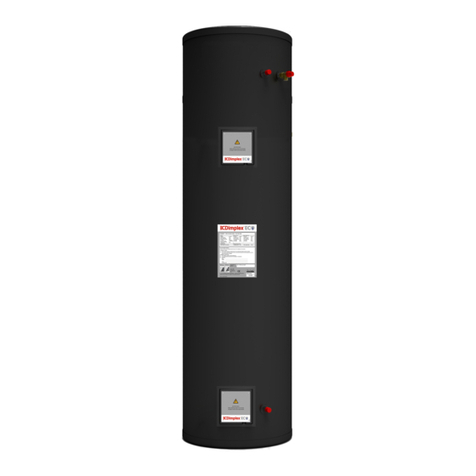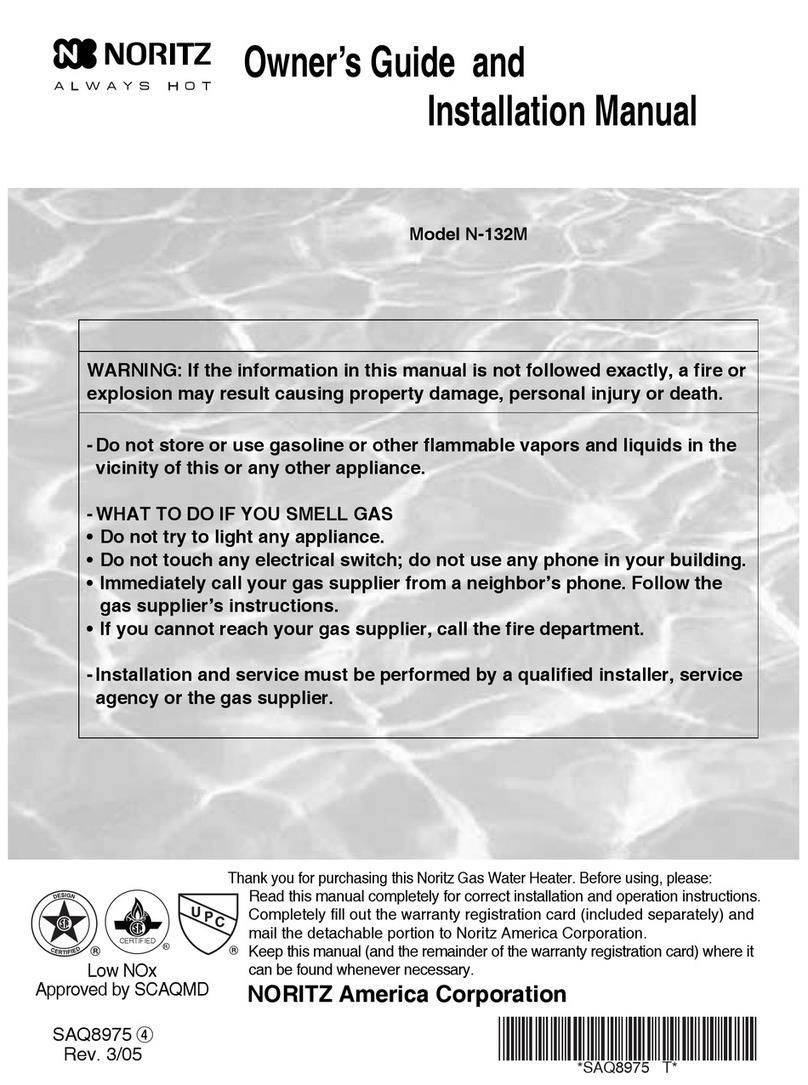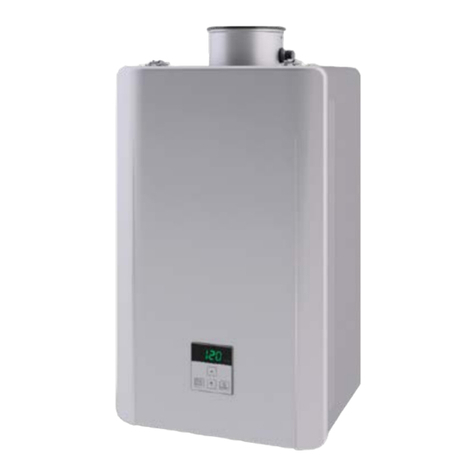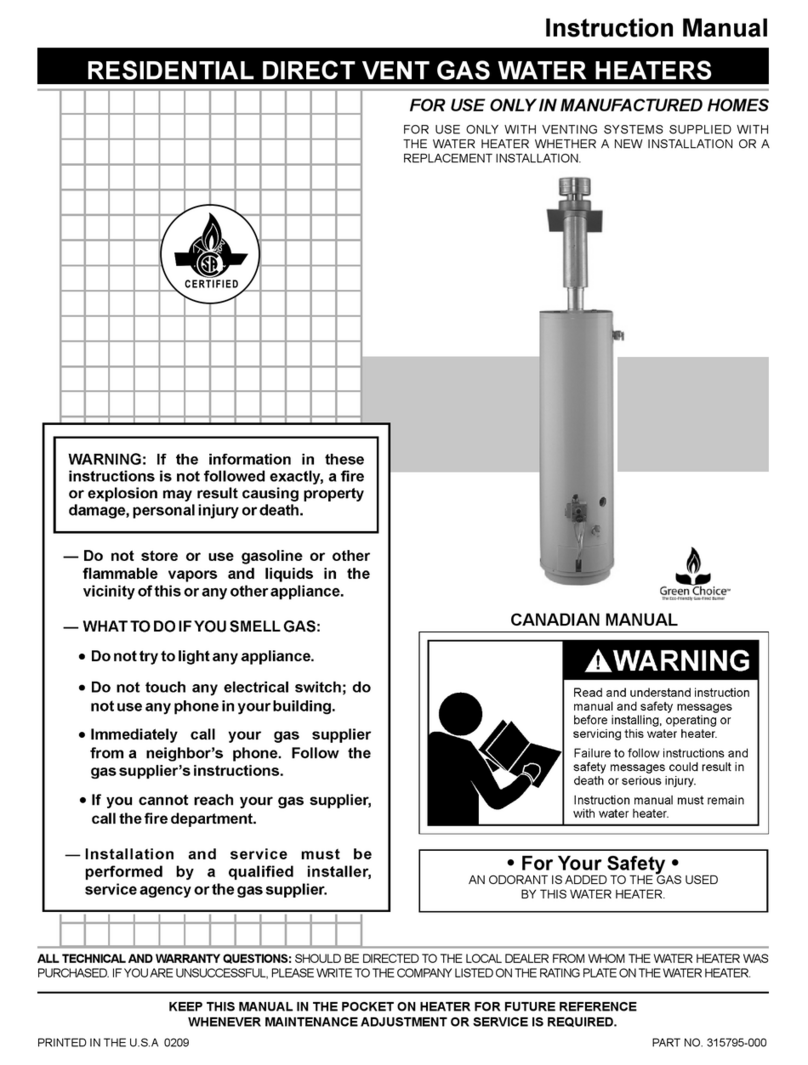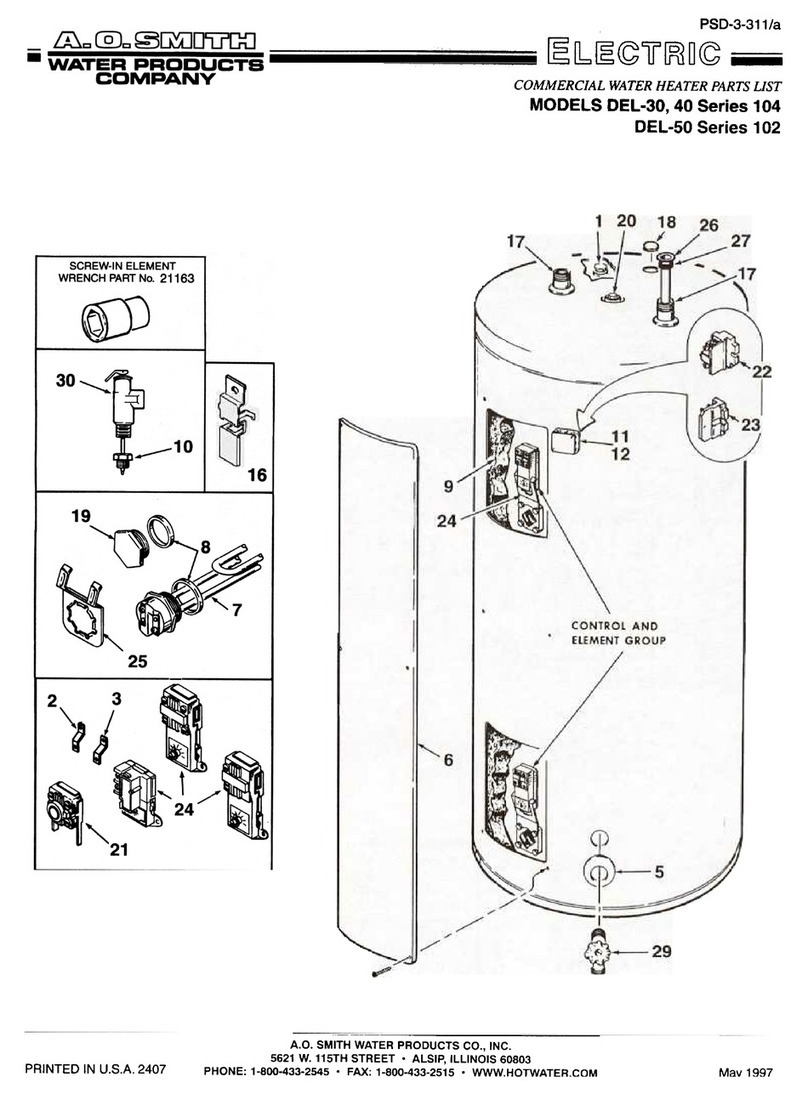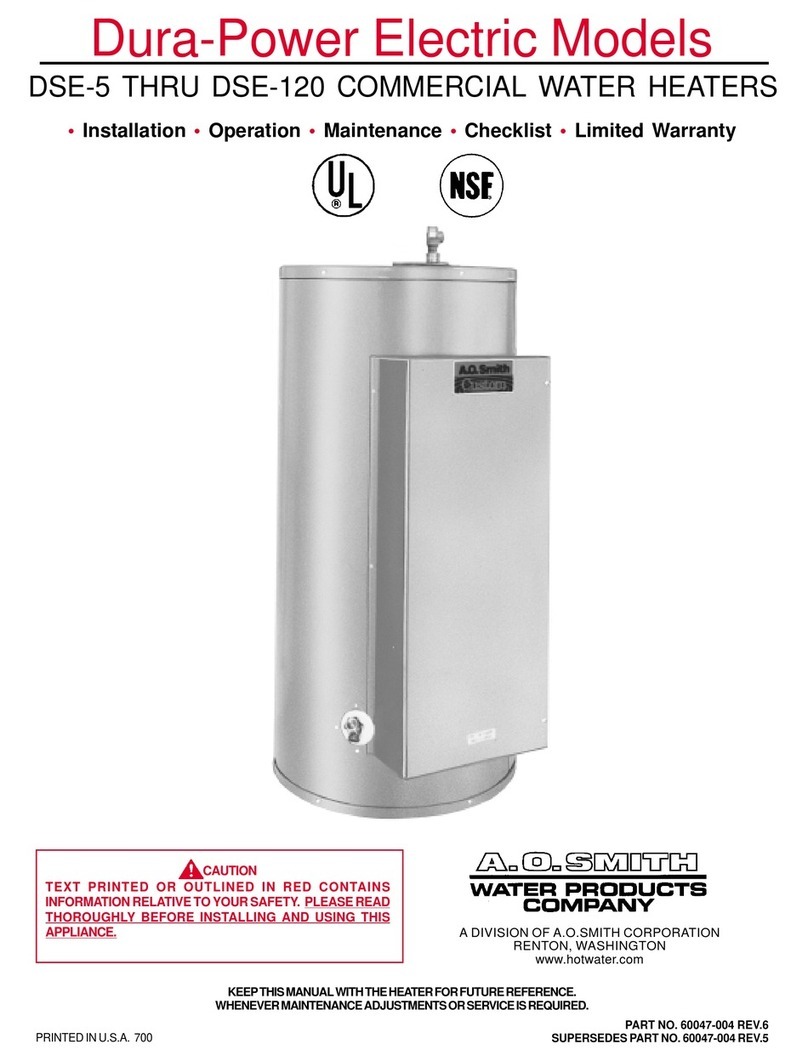
5
CLOSED WATER SYSTEM
A closed system will exist if a back-flow preventer (check valve),
pressure reducing valve, or other similar device is installed in
the cold water line between the water heater and the street main
(or well). Excessive pressure may develop due to the thermal
expansion of heated water causing premature tank failure or
intermittentreliefvalveoperation. This typeoffailure is not covered
by the limited warranty. An expansion tank may be necessary in
the cold water supply to alleviate this situation, see Figure 1.
Contact the local plumbing authority.
If the temperature and pressure relief valve on the appliance
discharges periodically, this may be due to thermal expansion
in a closed water supply system. Contact the water supplier or
local plumbing inspector on how to correct the situation. Do not
plug the temperature and pressure relief valve.
GAS CONNECTIONS
The minimum gas supply pressure for input adjustment is
5.0" W.C. (1.25 kPa) for natural gas 11.0" W.C. (2.74 kPa) for propane.
THEHEATERISNOTINTENDED FOROPERATIONATHIGHER
THAN 10.5" (2.6 kPa) FOR NATURAL & 13.0" (3.24 kPa) FOR
PROPANE WATER COLUMN SUPPLYPRESSURE. EXPOSURE
TO HIGHER GAS SUPPLY PRESSURE MAY CAUSE DAMAGETO
THECONTROLWHICHCOULDRESULTIN FIRE OR EXPLOSION.
If overpressure has occurred such as through improper testing of gas
lines or emergency malfunction of the supply system, the control must
becheckedfor safe operation. Makesurethat the outsideventson the
supply regulators and the safety vent valves are protected against
blockage. These are parts of the gas supply system not the
heater. Vent blockage may occur during ice storms.
IT IS IMPORTANT TO GUARD AGAINST CONTROL FOULING
FROM CONTAMINANTS IN THE GAS WAYS. SUCH FOULING
MAYCAUSE IMPROPER OPERATION, FIREOREXPLOSION.
All piping must comply with local codes and ordinances or with
the National Fuel Gas Code (ANSI Z223.1, NFPA 54) whichever
applies. Copper and brass tubing and fittings (except tin lined
copper tubing) shall not be used.
REFER TO FIGURE 1 FOR CONNECTION DETAILS. BEFORE
ATTACHING THE GAS LINE BE SURE THATALL GAS PIPE IS
CLEAN ON THE INSIDE.
TOTRAPANYDIRTORFOREIGNMATERIALINTHEGASSUPPLY
LINE, A DIRT LEG (SOMETIMES CALLED DRIP LEG) MUST BE
INCORPORATED IN THE PIPING, SEE FIGURE 1.The dirt leg must
be readily accessible. Install in accordance with recommendations of
serving gas supplier. Refer to the current edition of ANSI Z223.1.
To prevent damage, care must be taken not to apply too much
torque when attaching gas supply pipe to gas valve inlet. The
valve inlet has a hexagon shape for use with a backup wrench.
Apply joint compounds (pipe dope) sparingly and only to the
male threads of pipe joints. Do not apply compound to the first
two threads. Use compounds resistant to the action of liquefied
petroleum gases. Do not use teflon tape on gas valve.
DISCONNECT THE APPLIANCE AND ITS INDIVIDUAL SHUT OFF
VALVE FROM THE GAS SUPPLY PIPING SYSTEM DURING ANY
SUPPLY PRESSURE TESTING EXCEEDING 1/2 PSI
(3.5 kPa). GAS SUPPLY LINE MUST BE CAPPED WHEN
DISCONNECTEDFROMTHEHEATER.FORTESTPRESSURESAT
1/2 PSI (3.5 kPa) OR LESS, THE APPLIANCE NEED NOT BE
DISCONNECTED, BUT MUST BE ISOLATED FROM THE SUPPLY
PRESSURETESTBYCLOSINGTHEMAIN MANUALGAS VALVE.
BEFORE PLACING THE HEATER IN OPERATION, CHECK
FOR GAS LEAKAGE. USE SOAP AND WATER SOLUTION OR
OTHERMATERIALACCEPTABLEFORTHISPURPOSE.DONOT
USE MATCHES, CANDLES, FLAME OR OTHER SOURCES OF
IGNITIONTOLOCATE GASLEAKS.
RELIEF VALVE (P)- See FIGURE 1.
A NEW TEMPERATURE AND PRESSURE RELIEF VALVE
COMPLYING WITHTHE STANDARD FORRELIEF VALVESAND
AUTOMATIC GAS SHUT OFF DEVICES FOR HOT WATER
SUPPLY SYSTEMS, ANSI Z21.22 (CURRENT EDITION) MUST
BE INSTALLED IN THE HEATER IN THE MARKED OPENING
PROVIDED. THE VALVE MUST BE OFA SIZE (INPUT RATING)
THAT WILLBE ADEQUATE FOR YOUR SIZE HEATER.
Check the metal tag on the relief valve and compare it to the
heater’s rating plate. The pressure rating of the relief valve must
not exceed the working pressure shown on the rating plate of the
heater. In addition, the hourly Btu rated temperature steam
discharge capacity of the relief valve shall not be less than the
inputrating of the heater. NOVALVEISTOBE PLACED BETWEEN
THERELIEFVALVEANDTANK. DO NOTPLUGTHERELIEFVALVE.
The drain line connected to this valve must not contain a reducing
coupling or other restriction and must terminate near a suitable
drain to prevent water damage during valve operation. The
discharge line shall be installed in a manner to allow complete
drainage of both the valve and line. DO NOT THREAD, PLUG OR
CAP THE END OF THE DRAIN LINE.
VENTING
WARNING
NEVER OPERATE THE HEATER UNLESS THE INTAKE AND
EXHAUSTAREVENTEDTOTHEOUTDOORSANDHASADEQUATE
AIR SUPPLY TOAVOID RISKS OF IMPROPER OPERATION, FIRE,
EXPLOSION,ORASPHYXIATION.IFTHEWATERHEATERISBEING
INSTALLED AS A REPLACEMENT FOR AN EXISTING POWER
VENTED HEATER IN PRE-EXISTING VENTING, A THOROUGH
INSPECTION OF THE EXISTING VENTING SYSTEM MUST BE
PERFORMEDPRIORTOANYINSTALLATIONWORK.VERIFYTHAT
THECORRECTMATERIALASDETAILEDABOVEHASBEENUSED,
AND THAT THE MINIMUM OR MAXIMUM VENT LENGTHS AND
TERMINALLOCATIONASDETAILEDINTHISMANUALHAVEBEEN
MET. CAREFULLY INSPECTTHE ENTIRE VENTING SYSTEM FOR
ANYSIGNSOFCRACKSORFRACTURES,PARTICULARLYATTHE
JOINTS BETWEEN ELBOWS AND OTHER FITTINGS AND THE
STRAIGHTRUNSOFVENTPIPE.CHECKTHESYSTEMFORSIGNS
OFSAGGINGOROTHERSTRESSESINTHEJOINTSASARESULT
OFMISALIGNMENTOFANYCOMPONENTSINTHESYSTEM.IFANY
OF THESE CONDITIONS ARE FOUND, THEY MUST BE
CORRECTED IN ACCORDANCE WITH THE VENTING
INSTRUCTIONS IN THIS MANUAL BEFORE COMPLETING THE
INSTALLATIONANDPUTTINGTHEWATERHEATERINTOSERVICE.
WARNING
THESE MODELS ARE CERTIFIED FOR VERTICAL VENTING
ANDSIDE WALLVENTING. THEUNITCONSISTSOFAN INTAKE
VENT TERMINALAND AN EXHAUST VENT TERMINAL WHICH
MUSTBEUSEDTOTERMINATETHE VENTINGARRANGEMENT.
IF THE VENT TERMINALS SUPPLIED WITH THIS UNIT ARE
NOT USED TO TERMINATE THE VENTING ARRANGEMENT,
THERISK OF IMPROPER OPERATION,FIRE, EXPLOSION, OR
ASPHYXIATION WILLINCREASE.

